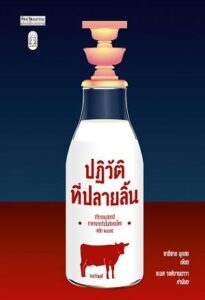
Chatichai Muksong ชาติชาย มุกสง
Bangkok: Matichon, 2022
Reviewed by Thanat Preeyanont (Ph.D. candidate of the National University of Singapore, HYI Visiting Fellow)
Thai cuisine constitutes a vital part of cultural elements that signify Thainess. Since the second half of the 20th century, the Thai state has deployed Thai cuisine as a cultural product that deepens the nationalistic feeling domestically and a product that familiarizes foreigners with Thailand globally. Despite the immense significance of Thai cuisine in politics and economy, only some scholars have researched foodways in Thailand. Chatichai Muksong’s Patiwat thi plailin: prap rot taeng chat ahan kankin nai sangkhom thai lang 2475 is one of a few that addresses foodways in modern Thai history. The originality and richness of the primary archival sources make this academic work a compelling read.
Patiwat thi plailin investigates the changes in tastes and the emergence of standard Thai cuisine due to the struggle for political hegemony between the antiroyalist and the royalist elites between the 1930s and 1950s. While many assume people have varied food palates according to individual preferences, Chatichai argues that the standard taste in Thai cuisine is a social construct of the state that perpetuates the regime’s hegemony. The author focuses on two watershed events in modern Thai political history: the overthrow of the absolute monarchy in 1932 and the restoration of the royalist forces during the Cold War. After the revolution in 1932, the People’s Party used modern mass media to introduce and campaign for nutritious consumption to strengthen citizens’ bodies, which resulted in a milder taste of foods. During the Cold War, the authoritarian government joined the royalists to restore the monarchy’s cultural power to fight communism. This process has revitalized the palace’s cuisine, making it the standard version of Thai food in the eyes of the middle class.
While Patiwat thi plailin emphasizes the state and state’s apparatuses as historical actors who changed the landscape of taste, it also brings economic factors into the analysis. Chapters 2 and 3 describe the developments of various agroindustries, including poultry, dairy, and sugar. They trace the changes in the availability of raw ingredients that enabled Thai people to consume more protein while campaigning for nutritious consumption. The rich statisticalsources back the claim for changes in Thai foodways, especially in chapter 3, where Chatichai has portrayed how Thai foods have become consistently sweeter due to the endorsement of the sugar industry.
The book’s most exciting part is analyzing how the palace’s cuisine became the standard Thai food in the 1950s. Chatichai illustrates the collaboration between home economists and critical figures of the royalist elite network, who reproduced the discourse of nutritious palace cuisine through media and social events. However, the analysis would be more irresistible if it provided readers with an example of how the social actors applied the discourse to explain how recipes reflect their nutritional value.
Overall, Patiwat thi plailin is a refreshing take on food in modern Thai history. It persuasively explains how Thai cuisine as it is known today came into being. The book would interest a general audience and scholars whose research involves the politics of culture, foodways, and modern Thai history.
